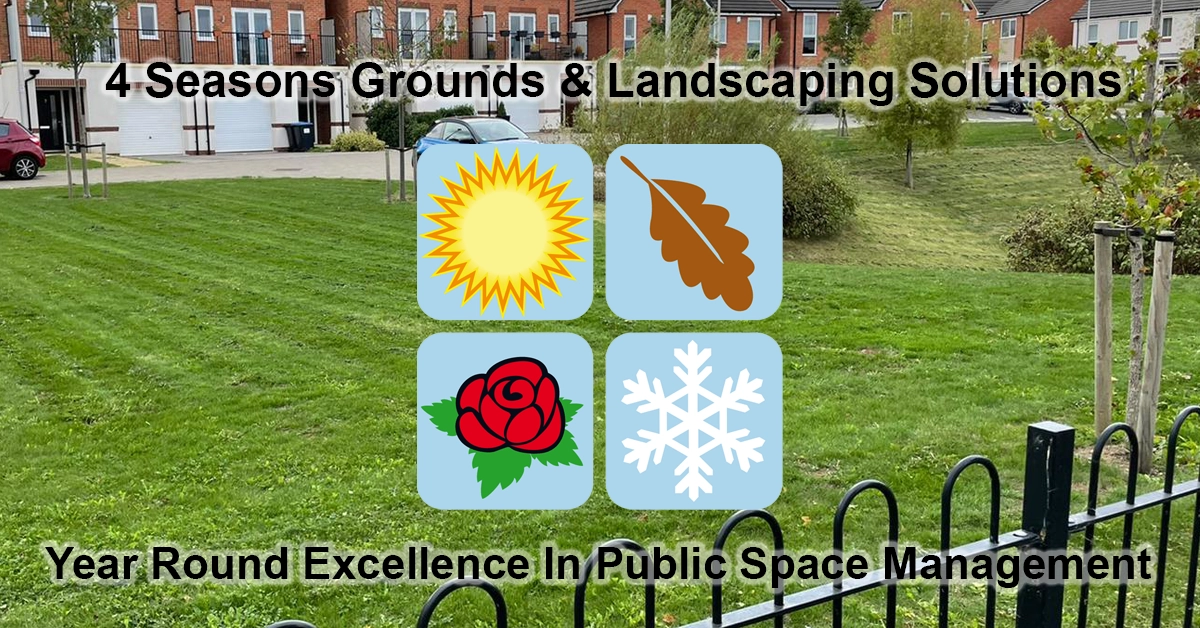How 4 Seasons Grounds & Landscaping Solutions Delivers Year-Round Excellence.
In the fabric of urban and suburban communities, public open spaces serve as vital connective gathering areas where community life unfolds across playgrounds, parks, town squares, and recreational areas. Yet the seamless functionality of these spaces relies on meticulous, often invisible care that adapts to changing seasonal demands.
Specialised grounds maintenance providers like 4 Seasons Grounds & Landscaping Solutions offer comprehensive service models designed specifically for public space management.
Maintaining public grounds represents a unique challenge that extends far beyond routine mowing or occasional planting. It requires a sophisticated understanding of horticulture, environmental science, public safety requirements, and community needs while navigating each season’s distinct demands.
A comprehensive year-round approach to grounds maintenance ensures public spaces remain accessible and safe. Specialised expertise is essential in this critical but often overlooked aspect of community infrastructure.
The Challenges of Public Open Spaces
Public open spaces differ fundamentally from private landscapes in both scope and purpose.
- They must withstand intensive use patterns
- Meet accessibility requirements
- Satisfy diverse stakeholder expectations
- Operate within strict municipal budgets
- They carry significant public safety implications that private landscapes typically don’t contend with.
A recent Urban Land Institute report on public space management noted: “Managing public open spaces means balancing ecological health with human experience. The most successful maintenance programs recognise these spaces as natural systems and community assets.”
The complexity increases when we consider the range of environments that fall under “public open spaces”:
- Municipal parks with diverse usage zones
- Playgrounds with specialised safety requirements
- Sports fields requiring performance-specific maintenance
- Public gardens demanding horticultural expertise
- Community gathering areas with high-traffic hardscapes
- Green corridors and natural areas requiring ecological management
- Civic buildings with showcase landscaping
Each environment requires different maintenance protocols, specialised equipment, and varying levels of expertise. This complexity explains why many municipalities and community organisations partner with comprehensive service providers rather than attempting to manage this multifaceted responsibility internally.
The Year-Round Service Model – Beyond Seasonal Thinking
Traditional approaches to grounds maintenance often follow a reactive, season-by-season model that creates gaps in care and results in inconsistent landscape quality. By contrast, the comprehensive service approach pioneered by providers like 4 Seasons Grounds & Landscaping Solutions embraces year-round stewardship that anticipates needs before they arise.
Spring: Revitalisation and Foundation Setting
Spring maintenance extends far beyond the visible aspects of landscape awakening. Comprehensive providers approach this season as the foundation for year-round success through:
- Soil health assessment and amendment programs based on scientific testing
- Early-season pest monitoring that prevents later infestations
- Structural pruning that shapes plant development for the entire growing season
- Specialised turf renovation that addresses winter damage
- Irrigation system commissioning with efficiency upgrades
- Early detection of drainage issues before they become problematic
This proactive approach prevents cascading maintenance issues that typically emerge in summer when reactive providers scramble to address problems that could have been prevented months earlier.
Summer. – Peak Performance Management
During summer months, public spaces experience their highest usage levels while simultaneously facing the most significant environmental stresses. Heat, drought, pest pressure, and intensive use create a perfect storm of maintenance challenges.
Comprehensive maintenance during this period includes:
- Adaptive mowing schedules that respond to growth patterns rather than rigid calendars
- Water management systems that balance conservation with plant health requirements
- Integrated pest management approaches that minimise chemical inputs
- Hardscape maintenance ensuring safe, functional pedestrian areas
- Special event preparation and recovery services
- Regular safety inspections of playground equipment and recreational facilities
The difference between basic and comprehensive summer maintenance becomes readily apparent in July and August, when poorly maintained spaces begin showing signs of stress, while properly maintained areas maintain their resilience and visual appeal.
Autumn – Transitional Care and Winter Preparation
For many maintenance providers, autumn represents little more than leaf removal. In a comprehensive service model, however, this season offers critical opportunities to strengthen landscapes before winter dormancy:
- Strategic tree care that addresses structural issues revealed by leaf drop
- Root zone conditioning that bolsters winter hardiness
- Soil aerification that relieves compaction from summer use
- Late-season fertilisation tailored to support root development
- Hardscape repair during ideal temperature conditions
- Installation of winter protection systems for sensitive landscape elements
These autumn interventions demonstrate how comprehensive maintenance thinking extends beyond immediate visual concerns to long-term landscape health and sustainability.
Winter – Active Management During Dormancy
Perhaps nowhere is the difference between basic and comprehensive maintenance more evident than during winter months. While basic service providers might disappear until spring, comprehensive management continues through:
- Snow and ice management with environmentally sensitive approaches
- Winter pruning that takes advantage of dormant-season visibility
- Hardscape maintenance during low-usage periods
- Planning and design work for spring improvements
- Equipment maintenance and team training
- Winter wildlife management and monitoring
This continuous presence ensures public spaces remain safe and accessible year-round while positioning them for rapid spring recovery.
The Technical Foundations of Comprehensive Care
Behind every well-maintained public space lies a foundation of technical expertise that informs daily maintenance decisions. Providers like 4 Seasons Grounds & Landscaping Solutions distinguish themselves with specialised knowledge and experience that elevates routine maintenance to strategic landscape management.
Soil Science and Plant Health
A sophisticated understanding of soil biology and plant physiology lies at the foundation of effective grounds maintenance. Comprehensive providers approach soil as a living system rather than simply a medium for plants, employing practices that:
- Balance soil biology through organic matter management
- Address site-specific pH challenges that affect plant performance
- Implement targeted fertility programs based on actual plant needs
- Manage soil compaction in high-traffic areas
- Create sustainable water infiltration systems
- Support beneficial soil microorganisms
This science-based approach starkly contrasts the “mow, blow, and go” mentality that characterises basic maintenance services.
Water Management Innovation
Water resource management represents one of the most technically demanding aspects of grounds maintenance, particularly as climate patterns become less predictable. Leading providers now implement:
- Intelligent irrigation systems with weather-responsive controllers
- Soil moisture monitoring technology
- Strategic use of drought-tolerant plantings in appropriate zones
- Rainwater harvesting and greywater utilisation where regulations permit
- Permeable hardscape solutions that reduce runoff
- Specialised drainage systems that prevent erosion and water damage
These water management strategies conserve resources, improve landscape performance, and reduce long-term maintenance costs.
Ecological Approach to Pest Management
Public spaces present unique challenges regarding pest management, as they must remain aesthetically pleasing and safe for diverse users, including children, pets, and wildlife. Comprehensive providers employ integrated pest management (IPM) frameworks that:
- Prioritise preventive cultural practices over chemical interventions
- Utilise biological controls when appropriate
- Apply targeted treatments only when thresholds are exceeded
- Time interventions based on pest life cycles
- Select low-impact materials when chemical applications are necessary
- Maintain detailed documentation of all management activities
This thoughtful approach maintains public safety while effectively addressing pest challenges that would otherwise compromise landscape health and appearance.
The Human Element: Community Engagement and Responsive Management
Technical expertise alone doesn’t create exceptional public spaces. The human dimension of grounds maintenance, understanding how communities interact with landscapes, is equally important. Forward-thinking providers recognise that maintaining public open spaces means serving people as much as managing plants.
Adaptive Management Based on Usage Patterns
Effective public space maintenance requires understanding the usage of different areas and adapting maintenance accordingly.
Possible actions required may be:
- Adjusting mowing heights based on recreational activities
- Timing maintenance operations to minimise disruption to users
- Creating specialised care protocols for high-visibility areas
- Adapting maintenance intensity to match usage levels
- Developing custom solutions for unique community needs
This responsive approach ensures maintenance activities support rather than hinder the intended functions of public spaces.
Communication and Stakeholder Engagement
The best maintenance providers recognise their role as partners in community development, not just service contractors. This partnership approach involves:
- Regular communication with stakeholders about maintenance activities
- Educational programming about sustainable landscape practices
- Transparency regarding maintenance challenges and solutions
- Soliciting community feedback to guide improvement efforts
- Participation in planning processes for future space development
Through these engagement strategies, grounds maintenance becomes a visible community asset rather than an invisible background service.
Measuring Success – The Metrics That Matter
How do we evaluate the effectiveness of public open space maintenance? While visual appeal certainly matters, comprehensive providers track multiple performance indicators:
- User satisfaction and community feedback
- Safety incident reduction
- Biodiversity metrics and ecological health indicators
- Water use efficiency compared to industry benchmarks
- Plant health and mortality rates
- Soil quality improvement over time
- Maintenance response times and issue resolution rates
This multifaceted evaluation approach acknowledges that successful public spaces must balance aesthetic, functional, environmental, and financial considerations.
The Economics of Comprehensive Maintenance
While comprehensive maintenance may require greater initial investment than basic service models, long-term economics strongly favour this approach. Decision-makers increasingly recognise that deferred maintenance ultimately costs more as minor issues become major problems requiring expensive remediation.
Comprehensive year-round maintenance delivers value through:
- Extended lifespan of landscape assets and infrastructure
- Reduced replacement costs for plants and materials
- Lower water and resource consumption
- Decreased liability exposure through proactive safety management
- Enhanced property values in surrounding areas
- Greater community utilisation of well-maintained spaces
When evaluated through this broader economic lens, comprehensive maintenance reveals itself as an investment rather than an expense.
The Future of Public Space Maintenance
Looking ahead, several emerging trends promise to reshape how we approach public open space maintenance:
- Integration of climate resilience strategies into standard maintenance protocols
- Greater emphasis on biodiversity support and habitat creation
- Adoption of electric and low-emission maintenance equipment
- Increased use of data analytics to optimise maintenance operations
- Development of specialised approaches for green infrastructure
- Growing focus on maintenance practices that support public health
Providers like 4 Seasons Grounds & Landscaping Solutions stand at the forefront of these innovations, continually evolving their comprehensive service models to address changing environmental conditions and community needs.
Conclusion – The Value of Specialised Expertise
Public open spaces represent some of our most valuable community assets. They are places where people connect, recreate, and experience nature. The quality of these experiences depends directly on the quality of maintenance these spaces receive. As communities increasingly recognise the importance of these spaces to public health, social cohesion, and environmental sustainability, the value of comprehensive, year-round maintenance approaches becomes increasingly apparent.
By embracing specialised expertise, implementing science-based practices, and maintaining a consistent year-round presence, comprehensive grounds maintenance providers transform public spaces from mere amenities into vital community assets that serve diverse needs across changing seasons. The difference between basic maintenance and comprehensive care becomes evident not just in the visual appearance of these spaces but in their functionality, safety, and contribution to community well-being.

